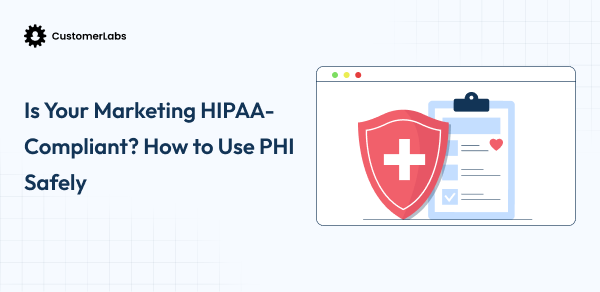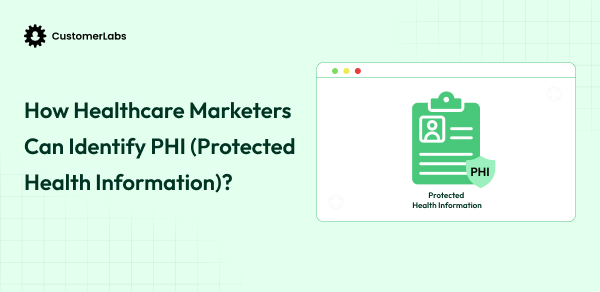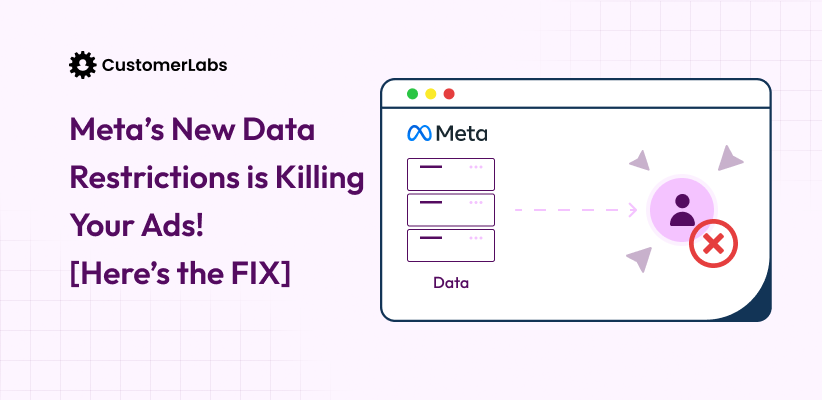Performance marketers in health and wellness, listen up: your Pixel and CAPI might be the biggest privacy threat lurking in your funnel. Even a single email address, when combined with bits of public data, can violate the privacy laws that you don’t want to.
Remember: In 2022, Meta paid alone over 82.6% of all GDPR fines. It is a shocking number and a clear warning. Millions of people’s personal information (PII) was exposed, and companies paid the price.
One careless Pixel and CAPI setup can put your entire funnel and reputation at risk. Mishandling user data (PII) can damage your credibility, erode customer trust, and lead to serious legal consequences under regulations like GDPR or HIPAA.
In this blog, we’re going to break down what PII data really is, what doesn’t qualify as PII, why performance marketers, the most common mistakes we see in the field, and actionable best practices must keep your funnels compliant and high-performing.
What is the Definition of PII?
Personally Identifiable Information (PII) is any data that can identify a specific individual either on its own or when combined with other information. If a piece of data can help someone figure out who a person is, it counts as PII.
For example, an email address or phone number can directly identify a user.
PII can be split into two types of identifiers: Direct Identifiers and Indirect Identifiers.
Understanding what qualifies as PII is the first step toward protecting personal data. Beyond compliance with GDPR, CCPA, and HIPAA, it’s about safeguarding your relationship with your customers because trust isn’t just nice to have; it’s the foundation of long-term performance marketing success.
Now that we’ve laid the groundwork with a clear, practical definition of PII, let’s dive deeper into its qualities, risks, and why every performance marketer should treat it like gold in their funnels.

Which Data Qualifies as PII Data?
It’s more than just a name or an email.
As a performance marketer in health and wellness, you’ve probably built more lead forms than you can count. Each one is asking for a little more, a name here, an email there, maybe a date of birth for personalization. But every field you add isn’t just a conversion lever; it’s a privacy liability.
Personally Identifiable Information (PII) is any data that can be linked back to an individual, and when combined with health-related details, it can quickly cross into Protected Health Information (PHI) territory, which also has 18 PHI identifiers. Even something as harmless-looking as a ZIP code or birth date can turn sensitive in the wrong context.
Not all PII is created equal. Some data points shout a user’s identity loud and clear, while others whisper, but both can land you in trouble if mishandled. Let’s break it down.
1. Direct Identifiers
Direct identifiers are the “front door keys” to someone’s identity. They reveal exactly who a person is, no detective work required.
- Full name: The simplest and most powerful identifier.
- Social Security Number (SSN): Your unique government-issued tag.
- Passport or driver’s license number: Official proof of identity.
- Email address: Especially when it includes your name (like [email protected]).
Examples:
Imagine a user signing up for a new wellness app. They enter their full name, email, and driver’s license number. That information alone can identify them instantly.
For marketers, collecting or storing direct identifiers is a big deal. You’re not just handling data; you’re handling legally protected information that demands strong privacy safeguards. Mishandle it, and your funnel isn’t just at risk; your business could be too.
2. Indirect Identifiers
Now, the sneaky stuff. Indirect identifiers don’t reveal someone’s identity on their own, but when combined with other pieces, they can point right back to an individual. Think of them as puzzle pieces: one piece alone is harmless, but together, they create the full picture.
- Date of birth: Harmless alone, but combine it with a ZIP code, and it’s more specific.
- Place of birth: Paired with age or gender, it narrows down the field.
- Mother’s maiden name: Often used as a security question, surprisingly easy to guess from social profiles.
- Phone number: Especially if linked to online accounts.
- ZIP code or city: Generic on its own, but powerful when combined with other identifiers.
Examples Scenario:
Someone knows your ZIP code, date of birth, and favorite workout routine. Separately, harmless. Together? They can narrow down your identity and even link back to you.
For performance marketers, this is where compliance often gets tricky. You might think, I’m only asking for a ZIP code or birth date, what’s the harm? But under privacy laws like GDPR, CCPA, or HIPAA, if these details can be tied to an individual, they count as PII.
Treat indirect identifiers with the same care as direct ones. Even if they don’t reveal a name outright, they can connect the dots, and a single misstep can put your funnel and reputation at risk.
Here’s below from a Carnegie Mellon University study that revealed that even simple demographic details like gender, ZIP code, and date of birth are often enough to uniquely identify most individuals.
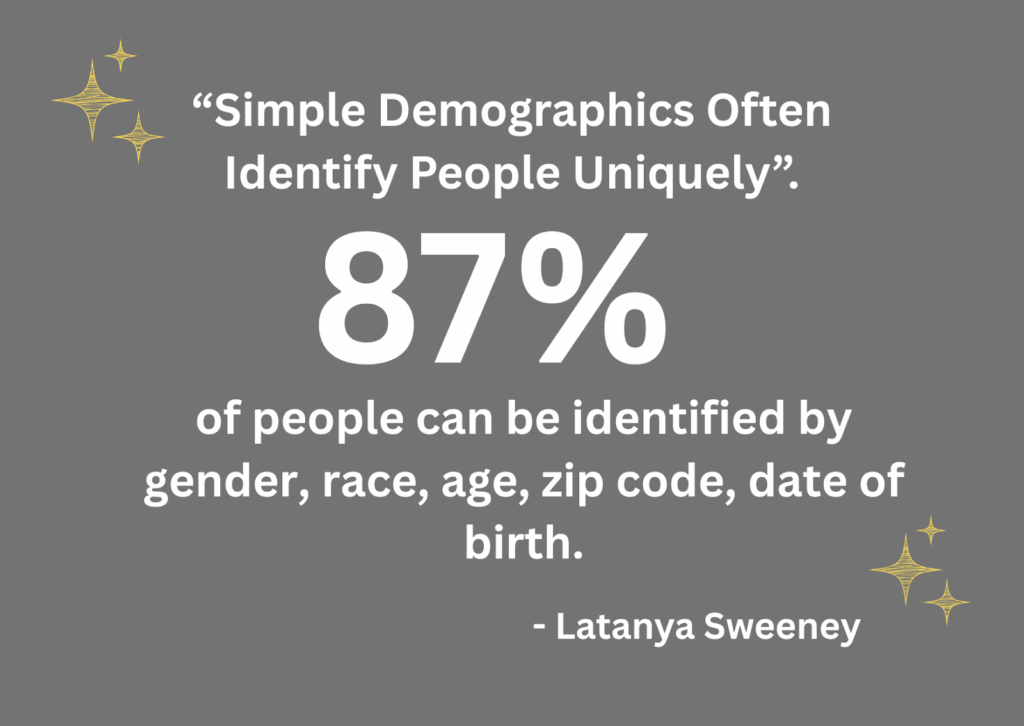
Moving forward to the sensitive PII
What is Sensitive PII?
Sensitive PII isn’t just data that identifies someone; it’s the kind of information that can seriously harm both your users and your business if mishandled. In healthcare marketing, PHI (Protected Health Information) is a type of sensitive data that includes personal identifiers combined with health details, making it especially high-risk. In health and wellness marketing, this is especially critical because even a small leak can compromise trust, reputation, and compliance.
Sensitive PII often overlaps with PHI (Protected Health Information) when personal identifiers are combined with health-related data; you’re handling the crown jewels of user information. If this data falls into the wrong hands, the consequences are serious.
- Financial information: Bank account numbers, credit card details, payment histories.
- Medical and health records: Prescriptions, diagnoses, lab results, or doctors’ notes.
- Biometric data: Fingerprints, facial recognition, retina scans, DNA.
- Login credentials: Usernames, passwords, or PINs.
For performance marketers, think of sensitive PII as the red zone in your funnel, the data area where even a small mistake can lead to major compliance fallout.
If misused:
- You could expose users to identity theft or financial fraud.
- Medical or personal information could be compromised, triggering HIPAA violations.
- Your brand reputation and customer trust could take a massive hit.
Even if your goal is simple, like improving ad targeting, building lookalike audiences, or personalizing content, mishandling sensitive PII can lead to legal penalties, heavy fines, and irreparable loss of trust.
We understand what is qualified as PII and sensitive data. Now, let me unpack the other side, which is non-sensitive data.
What is Non-Sensitive PII?
Not all data is risky or personally revealing. Some information you work with every day, like aggregated ad stats, anonymized reports, or general audience trends, is known as non-sensitive PII.
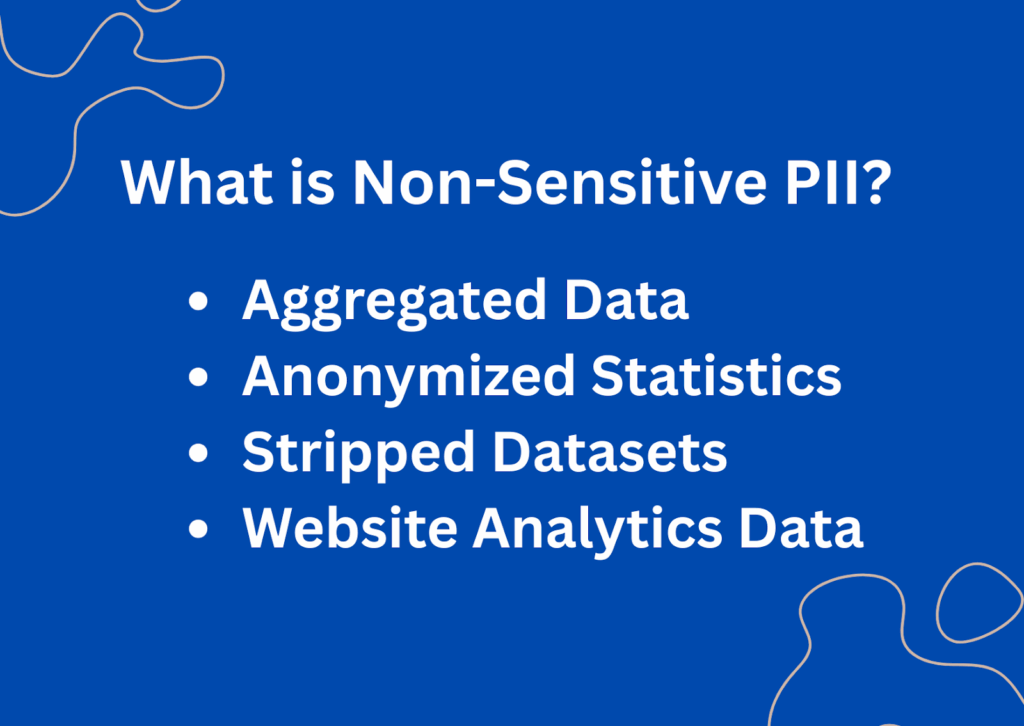
Think of it like a website heatmap: you can see where users click, how far they scroll, or which city most visitors come from, but you can’t tell exactly who they are. Similarly, knowing that 40% of your customers are from California or that the average order value is $85 is actionable for marketing, but doesn’t cross privacy lines.
Non-sensitive PII can become sensitive if combined with other identifiers like emails, phone numbers, or device IDs. Suddenly, seemingly anonymous data paints a clear picture of a real person, which can put your campaigns and your company at risk.
As a marketer, always ensure:
- Pixel events, exported reports, and synced audiences don’t include direct identifiers.
- Tools that encrypt, hash, or aggregate data are used whenever possible.
- Even general personalization strategies respect data minimization principles.
In today’s privacy-first landscape, the smartest marketers don’t just chase ROAS and performance; they maximize results while keeping user trust intact.
Because in today’s privacy-focused world, the smartest marketers aren’t just chasing performance, they’re doing it responsibly. Staying aware of what counts as non-sensitive and keeping both your campaigns and your customers safe.

Sensitive vs. Non-Sensitive PII: What Marketers Need to Know
If you’re running health and wellness campaigns, you’re collecting data every day from website visits to sign-ups and purchases. But not all personal data is equal. Knowing which data is high risk and which is low risk can make the difference between smooth campaigns and serious compliance headaches.
Here’s a quick comparison for marketers:
| Type of PII | Examples | Risk Level | How to Handle Ads | Pixel / CAPI Guidance |
| Sensitive PII | SSN, medical records, health info | High (Red Zone) | Strong encryption, server-side only, strict compliance | Don’t send via client-side pixels; use server-side CAPI with encryption |
| Non-Sensitive PII | Email, phone, demographics | Medium (Yellow Zone) | Hash, anonymize, or aggregate before syncing | Can send via CAPI or hashed pixel events safely |
| Aggregated/anonymized | Reports, summaries, performance | Low (Green Zone) | Safe for analysis and dashboards | Safe for analytics and optimization; no personal info |
Every interaction, whether it’s a pixel firing, a CRM upload, or a CAPI sync, is a decision point. Treating PII correctly not only protects your users but also ensures your campaigns keep running without compliance.
Understanding which PII is sensitive and which is non-sensitive lets you safely feed your ad platforms, optimize campaigns, and protect both your users and your brand. In health and wellness marketing, performance and privacy are inseparable.
Let’s move to the section where you can get a clear differentiation between PII and personnel details.

What is the difference between PII vs. Personal / Personnel Details?
Let’s be honest, even seasoned performance marketers get tangled up in these terms: personal data, PII, personnel details. And in the health and wellness space, mixing them up can do more than confuse your data team; it can land your campaigns in hot compliance trouble.
Here’s the simplest way:
Personal data
Personal data includes all the information you collect about an individual, such as their name, email, phone number, and location. This data helps with audience segmentation and targeting. However, when certain pieces of this data are combined, they can identify a specific person. That’s where PII (Personally Identifiable Information) comes in.
Personally Identifiable Information(PII)
Personally Identifiable Information (PII) refers to any combination of data that can identify a specific individual, for example, a name paired with an email address or phone number.
If this information is shared through tracking tools like pixels or Conversion API (CAPI) without proper user consent, it can lead to serious compliance violations rather than legitimate ad campaigns.
| Personnel Data | PII data | Example | What It Means |
|---|---|---|---|
| Name/Address | Name + Address | Jane Smith, 123 Main St | You can pinpoint exactly where she lives, that’s PII. |
| Name/Date of Birth | Name + Date of Birth | Jane Smith, 01/01/1990 | Direct identification is definitely sensitive. |
| Health Info/ Contact | Health Info + Contact | Jane Smith, asthma treatment info | PHI-level concern requires HIPAA-grade protection. |
A single data point might look harmless (like a ZIP code or email), but when paired with another data point, it becomes personally identifiable.
Now, think about how your ad campaigns, pixels, or CAPI setups collect and send data. When users sign up for a free health quiz, register for a wellness program, or even add supplements to their cart, every click can pass data back to Meta or Google.
If that data includes identifiers like email or phone without encryption or consent, it’s no longer just personal data; it’s PII exposure.
Let’s dive deeper into this differentiation of sensitive and non-sensitive PII
Now, how does this matter to performance marketing? Let’s reveal
Why PII Matters in Performance Marketing
If you want your health and wellness campaigns to actually perform, PII isn’t just nice to have; it’s the engine behind precision targeting. The right personal data lets you reach the right people at the right time, making every ad dollar count.
Hashed PII keeps your account privacy compliant
Imagine you have a landing page with a form targeting cancer patients, and the user fills in their details. Let’s say it is their experience with chemo sessions. This form includes their name, email address, residential address, and zip code.
And if you collect this data and send it as it is to Meta. Meta will block and flag this ad account mercilessly for sharing the details of patients (personal information)who have booked an online chemotherapy treatment.
What can be done in this situation? The performance marketer needs to hash out the details of the person (the Patient’s personal information) who has booked a therapy session. So, after hashing and feeding that into Meta, its algorithm will recognize this as an event so that the data can be shared for lookalike audience segmentation without violating privacy compliance.
PII Powers Smarter Audience Targeting
Think about it: generic audience data can only get you so far. But email addresses, phone numbers, or loyalty IDs will let you:
- Retarget people who already showed interest in your brand.
- Build highly accurate lookalike audiences on platforms like Meta, Google, or TikTok.
- Combine behavioral signals with PII for campaigns that feel personal, not random.
Basically, PII turns your audience from someone, somewhere, into your next loyal customer.
How is PII important in Retargeting and Lookalikes?
Platforms like Meta, Google, and TikTok rely on hashed PII emails, phone numbers, or app IDs for Custom Audiences and Lookalikes. Hashing scrambles the data so platforms can match users without ever exposing their sensitive health info. This keeps your campaigns legal and safe while still highly targeted.
| Platform | How PII Is Used | Marketing Benefit |
|---|---|---|
| Meta | Upload hashed email/phone lists to match users | Retarget high-intent users & create Lookalike Audiences for acquisition |
| Customer Match via hashed emails | Serve search/display campaigns to known customers | |
| TikTok | Custom Audiences & Lookalikes | Scale campaigns to similar users who are likely to engage |
Every website visit, signup, or purchase can feed your ad campaigns through pixels or server-side CAPI.
Using hashed PII here:
- Keeps sensitive health info secure.
- Ensures your retargeting campaigns are accurate.
- Helps platforms build Lookalike Audiences without exposing raw user data.
Without PII, your campaigns are guessing games. With PII, you can reach the right people safely, optimize every ad dollar, and scale acquisition while staying fully compliant.
For performance marketers in health and wellness, that balance between personalization and privacy is non-negotiable. PII is a double-edged sword that can boost your ad campaigns and as well as it can ban your ad account.
PII Under GDPR and HIPAA: Legal Perspectives
So far, we’ve explored personal data, PII, and why it matters in marketing campaigns. Now, let’s bring in the legal angle, because understanding the rules is crucial, especially if you’re a health and wellness marketer handling sensitive information.
PII is powerful, but the law sets the guardrails. Knowing the rules keeps your campaigns running smoothly without risking fines, account suspensions, or customer trust.
GDPR: Europe’s Data Rules
The General Data Protection Regulation (GDPR) applies to anyone handling the data of EU residents, even if your business is outside Europe.
- Any information relating to an identified or identifiable individual. This includes names, emails, IP addresses, or even behavioral data if it can identify someone.
- You must get explicit consent before using data for marketing or analytics.
- Individuals can request access, deletion, or corrections of their data.
Meta Platforms Ireland Limited faced a €265 million fine for insufficient technical and organizational measures to ensure information security, underscoring the necessity for robust data protection practices.
For health and wellness campaigns targeting EU users, even a simple email list or app usage data can fall under GDPR, so consent and transparency are essential.
HIPAA: U.S. Healthcare Privacy Rules
HIPAA is narrower but strict, focusing on protected health information (PHI) in the U.S.
- Applies to healthcare providers, insurers, and any business handling health data.
- Defines PHI as health-related data that can identify a person, including medical records, treatment info, or health conditions.
- Strict handling rules: PHI must be stored securely, shared only with authorized parties, and protected at all times.
In 2023, 725 data breaches were reported to the Office for Civil Rights (OCR), affecting over 133 million records. This marks a significant increase in both the number of breaches and the volume of compromised data compared to previous years.
This means even marketing lists tied to health programs or conditions need HIPAA-safe handling, like hashing, encryption, and explicit consent.
Here’s how this ties into your PII journey:
- GDPR and HIPAA laws are the guardrails that make sure your turbo engine (PII) doesn’t crash your car.
Knowing which rules apply to which users (EU, US general, or healthcare-specific) ensures your campaigns drive growth safely. It leaves you with irreplaceable costs(Ad account block) you have to pay if you handle the PII incorrectly.
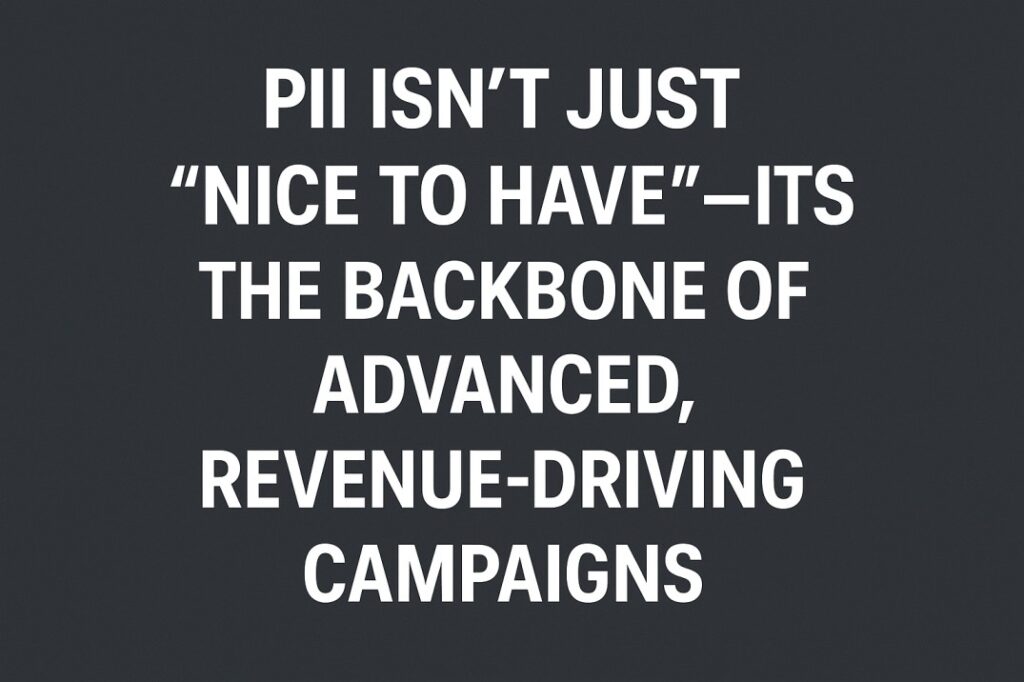
The Risks of Mishandling PII
Here’s where the story gets serious. Mismanaging PII doesn’t just trigger an internal headache; it can hit your campaigns, your compliance, and your bottom line.
Consequences are:
- Breaking HIPAA or GDPR rules
- Exposing health-related PII (like medical history, conditions, or treatment details) without consent is a legal violation.
- Even combining seemingly harmless PII (like email + DOB + location) can push your data into a regulated category.
- Damaging Brand Reputation
- Consumers in health and wellness care deeply about privacy.
- A single data mishap can erode trust, causing churn and negative press.
- Reducing ROAS due to lost trust or account suspensions
- Platforms can suspend accounts for mishandling PII or violating policies.
- Customers stop engaging if they feel unsafe, reducing conversion rates and increasing ad costs.
Imagine driving a sports car, it’s powerful and can go really fast. But if you ignore traffic rules and speed limits, that power quickly turns into a legal problem.
The same goes for marketing data. You can collect and use a lot of data to boost performance, but if you don’t follow privacy laws or consent requirements, your fast growth turns into a compliance issue. And several common mistakes happen in health & wellness marketers.
Common Mistakes Health & Wellness Marketers Make
As we’ve established, mishandling PII can lead to severe consequences, including legal repercussions and loss of consumer trust. Here are some prevalent mistakes marketers often make:
Sending Raw Emails, Phone Numbers, or Health Information to Platforms Without Encryption
Sharing sensitive data without proper encryption exposes it to unauthorized access, violating privacy regulations like GDPR and HIPAA. For instance, transmitting health information through unencrypted channels can lead to data breaches and hefty fines.
Using Third-Party Lists Without Explicit Consent
Purchasing or utilizing third-party data lists without obtaining explicit consent from individuals is a breach of privacy laws. Under GDPR, consent must be freely given, specific, informed, and unambiguous. Similarly, HIPAA mandates that healthcare providers obtain patient consent before sharing their Protected Health Information (PHI) with third parties.
Ignoring Opt-Outs or Privacy Preferences in Campaigns
Failing to honor users’ opt-out requests or privacy preferences can result in non-compliance with privacy laws. Both GDPR and HIPAA require organizations to respect individuals’ rights to control their personal data, including the right to withdraw consent at any time.
Meta’s Pixel and Its Implications
Meta’s Pixel is a tool that allows marketers to track user interactions on their websites and optimize advertising campaigns. However, when used improperly, it can lead to significant privacy violations.
Recent Legal Actions Involving Meta’s Pixel
- Reid Health Settlement: In October 2025, Reid Health settled a class-action lawsuit for $25 per affected individual due to the improper use of Meta’s Pixel, which allegedly exposed sensitive health information without consent.
- Flo Health Lawsuit: A jury found that Meta violated California privacy laws by using consumers’ private health information for commercial purposes without their consent.
These cases underscore the importance of ensuring that tracking technologies comply with privacy regulations. Let’s look at a real-world example who has saved and improved its ad account.
How Leading Personal Wellness Brands Protected PII and PHI Using 1PD Ops
A leading Indian personal wellness brand had built a loyal following and strong market presence. They were running digital ad campaigns (including on Meta Platforms/Facebook) to grow their e-commerce performance.
The Problem Before Using CustomerLabs
Things changed suddenly when Meta tightened its data/privacy policies for health & wellness brands. The brand faced the following issues:
- Meta has blocked their purchase, a bottom-funnel event, because their data was flagged as sensitive.
- Custom audience targeting and lookalike audiences were also blocked. They couldn’t retarget with high-intent website visitors or build lookalikes.
- Their campaign scaling was completely stuck, but the ad spend was still flowing; however, performance was stagnant.
- They discovered that the standard setup (e.g., using Shopify’s built-in Conversion API) was insufficient for their specific use case as a health & wellness brand under Meta’s stricter rules.
Even though they had audience, traffic, and campaigns set up, the changes in data/privacy led to major disruption; they lost tracking, targeting, and scaling.
The Solution & Journey With 1PD Ops
IPD Ops provides its privacy in building service by:
- Audit of tracking setup
- Reviewed what the pixel, events, and URLs were sending to Meta. Removed anything flagged (medical conditions, treatments, sensitive identifiers).
- Enabled Meta’s core data restrictions in Events Manager to automatically limit sensitive data.
- Shift to server-side tracking (CAPI) + data scrubbing
- Moved from purely client-side tracking to server-side (Conversions API) so they could control and “clean” the data before sending it.
- Scrubbed URLs (removing disease names, medical/symptom keywords) and renamed event names (e.g., instead of book_diabetes_consult, used a generic conversion_event1).
- Avoided passing sensitive custom parameters; only passed generic, safe data (purchase value, category ID, etc).
- Custom event structuring & audience activation
- Built multiple custom events by product category and gender (e.g., men’s category vs women’s) to allow deeper optimization and scaling.
- Because the cleaned, properly signalled data was flowing, they regained the ability to build retargeting audiences and lookalikes.
The Growth Outcome
- After implementing the above changes, the brand achieved a 9.3 EMQ (Event Match Quality) score in Meta’s Events Manager, indicating high-quality event matching for ad optimisation.
- They regained full ability to send both top-funnel and bottom-funnel events, for both known and anonymous users, while staying compliant with privacy laws.
- They could resume retargeting, lookalike audiences, and scale their campaigns again, no longer stuck.
- In effect, what they lost due to policy changes, they recovered via a stronger first-party data setup.
- The brand is now positioned to run ad strategies based on all the campaigns you have in mind, rather than being limited by data/privacy blocks.
This is the way 1PD Ops provides its service to improve the brand’s EMQ and boost its Ad campaigns and sales. To know more about 1PD Ops and its privacy compliance, the section below will be a treat for you.
How does 1PD Ops help to run your Ad campaigns privacy-compliant?
In the era of stringent privacy regulations, health and wellness marketers face a tightrope walk: leveraging first-party data for performance while keeping customer data secure. 1PD Ops bridges this gap by embedding privacy directly into marketing operations.
Real-Time Monitoring & Unified Data Control
1PD Ops continuously monitors all first-party data flows from website interactions to CRM and offline touchpoints. This ensures:
- Immediate detection of anomalies or unauthorized access
- Consolidation of customer signals into a single unified profile
- Seamless audience activation for campaigns without exposing raw PII
This real-time oversight prevents inadvertent leaks and keeps marketers confidently compliant with GDPR, HIPAA, and state-level privacy laws.
Advanced Encryption & Lifelong Data Protection
Customer data in 1PD Ops is encrypted both in transit and at rest, minimizing the risk of breaches. Coupled with lifelong first-party cookies, marketers can:
- Retain critical conversion data (like fbclid or gclid) permanently
- Improve attribution reporting and ROAS
- Use hashed signals for Meta, Google, and TikTok without exposing sensitive PII
The platform ensures your high-value audience signals are secure yet actionable, allowing safe personalization and retargeting.
Breach Prevention and Compliance Assurance
1PD Ops incorporates proactive breach detection mechanisms, identifying potential vulnerabilities before they escalate. Features include:
- Server-side tracking and Conversions API for secure signal collection
- Aggregated and anonymized offline and online signals
- Automatic compliance checks for GDPR and HIPAA-sensitive data
By integrating privacy at the core, 1PD Ops allows marketers to:
- Build Customer Trust: Transparency in data handling fosters long-term loyalty.
- Optimize Audience Segmentation: First-party signals enable precise targeting without risking compliance violations.
- Scale Campaigns Confidently: Safe, enriched data fuels AI-driven optimization on Meta, Google, and TikTok.
Stats from 1PD Ops users show:
- 50%+ reduction in unauthorized data sharing
- Significant drop in breach incidents
- Higher audience match rates on Meta and Google due to enriched, privacy-safe signals
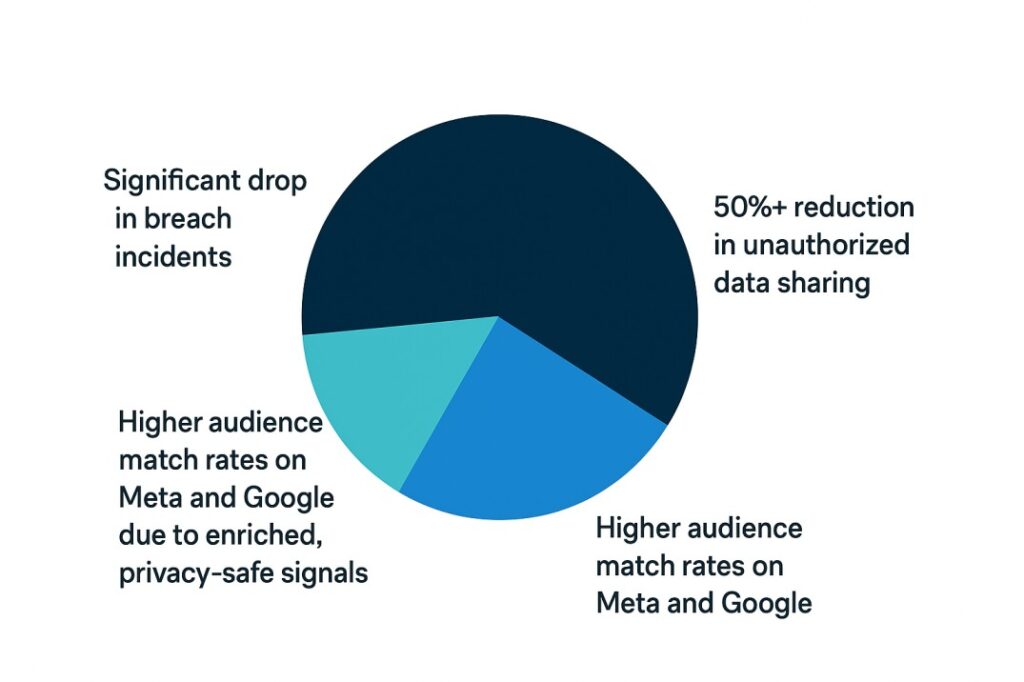
1PD Ops is the only platform with privacy baked into marketing workflows, not bolted on afterward. It’s time to look into the best practices to protect PII data.
Best Practices to Protect PII
Protecting Personally Identifiable Information (PII) isn’t just about compliance; it’s about keeping your audience’s trust and your campaigns running smoothly. Here are the key best practices every health and wellness marketer should follow:
- Strong Passwords – Use complex, unique passwords for all marketing and data platforms.
- Multi-Factor Authentication (MFA) – Add an extra security layer to prevent unauthorized access.
- Regular Software Updates – Keep platforms, CRMs, and tracking tools up to date to patch vulnerabilities.
- Employee Education – Train your team on privacy compliance, phishing, and secure data handling.
- Data Minimization & Anonymization – Collect only the data you need, and anonymize PII wherever possible.
Let’s get to conclude.
Conclusion
Throughout this guide, we’ve explored the critical journey of personal data, PII, marketing use, and compliance risks.
In today’s privacy-first world, PII isn’t just another marketing data point; it’s a responsibility. Whether you’re running retargeting campaigns or managing CRM data, every piece of identifiable information carries weight.
Mishandle it, and you risk compliance penalties, broken trust, and stalled growth. But when protected correctly, PII becomes the backbone of ethical, high-performance marketing. 1PD Ops decides to open a free14-days trial for the marketers to
Treat every identifier like gold, secure it, encrypt it, and use it responsibly. Because in the long run, brands that protect privacy don’t just survive regulation, they earn loyalty and win the market. Book a demo to own PII and PHI free Ad campaigns with 1PD Ops
